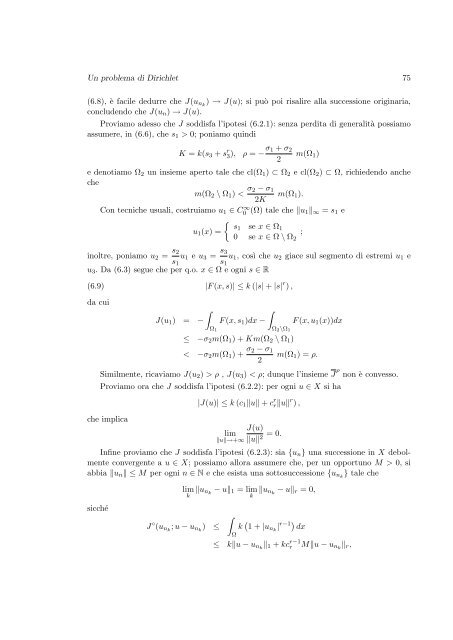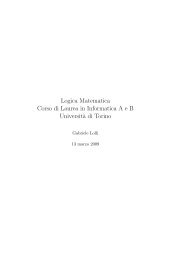Applicazioni della teoria del minimax a problemi ... - Portale Posta DMI
Applicazioni della teoria del minimax a problemi ... - Portale Posta DMI
Applicazioni della teoria del minimax a problemi ... - Portale Posta DMI
You also want an ePaper? Increase the reach of your titles
YUMPU automatically turns print PDFs into web optimized ePapers that Google loves.
Un problema di Dirichlet 75<br />
(6.8), è facile dedurre che J(unk ) → J(u); si può poi risalire alla successione originaria,<br />
concludendo che J(un) → J(u).<br />
Proviamo adesso che J soddisfa l’ipotesi (6.2.1): senza perdita di generalità possiamo<br />
assumere, in (6.6), che s1 > 0; poniamo quindi<br />
K = k(s3 + s r 3), ρ = − σ1 + σ2<br />
2<br />
m(Ω1)<br />
e denotiamo Ω2 un insieme aperto tale che cl(Ω1) ⊂ Ω2 e cl(Ω2) ⊂ Ω, richiedendo anche<br />
che<br />
m(Ω2 \ Ω1) < σ2 − σ1<br />
2K m(Ω1).<br />
Con tecniche usuali, costruiamo u1 ∈ C ∞ 0 (Ω) tale che u1∞ = s1 e<br />
inoltre, poniamo u2 = s2<br />
u1 e u3 =<br />
s1<br />
s3<br />
s1<br />
<br />
s1 se x ∈ Ω1<br />
u1(x) =<br />
;<br />
0 se x ∈ Ω \ Ω2<br />
u3. Da (6.3) segue che per q.o. x ∈ Ω e ogni s ∈ R<br />
(6.9) |F (x, s)| ≤ k (|s| + |s| r ) ,<br />
da cui<br />
<br />
J(u1) = −<br />
Ω1<br />
u1, così che u2 giace sul segmento di estremi u1 e<br />
<br />
F (x, s1)dx − F (x, u1(x))dx<br />
Ω2\Ω1<br />
≤ −σ2m(Ω1) + Km(Ω2 \ Ω1)<br />
< −σ2m(Ω1) + σ2 − σ1<br />
2<br />
m(Ω1) = ρ.<br />
Similmente, ricaviamo J(u2) > ρ , J(u3) < ρ; dunque l’insieme J ρ non è convesso.<br />
Proviamo ora che J soddisfa l’ipotesi (6.2.2): per ogni u ∈ X si ha<br />
che implica<br />
|J(u)| ≤ k (c1u + c r ru r ) ,<br />
J(u)<br />
lim = 0.<br />
u→+∞ u2 Infine proviamo che J soddisfa l’ipotesi (6.2.3): sia {un} una successione in X debolmente<br />
convergente a u ∈ X; possiamo allora assumere che, per un opportuno M > 0, si<br />
abbia un ≤ M per ogni n ∈ N e che esista una sottosuccessione {unk } tale che<br />
sicché<br />
lim k unk − u1 = lim k unk − ur = 0,<br />
J ◦ (unk ; u − unk ) ≤<br />
<br />
Ω<br />
k 1 + |unk |r−1 dx<br />
≤ ku − unk 1 + kc r−1<br />
r Mu − unk r,




![Introduzione ai sistemi Wiki [PDF] - Mbox.dmi.unict.it](https://img.yumpu.com/16413205/1/184x260/introduzione-ai-sistemi-wiki-pdf-mboxdmiunictit.jpg?quality=85)












